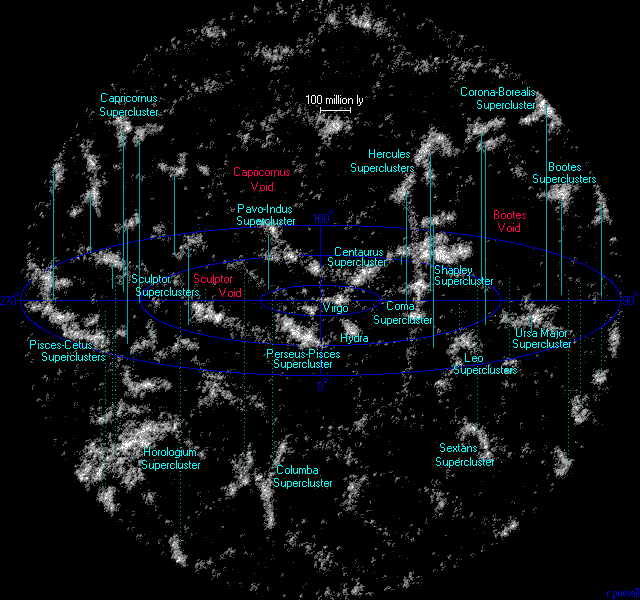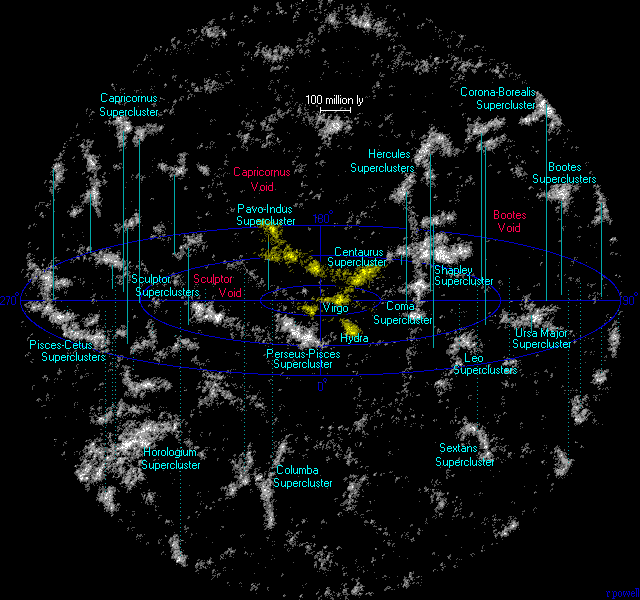|
Superclusters
A supercluster is a large group of smaller galaxy clusters or galaxy groups; they are among the largest known structures in the universe. The Milky Way is part of the Local Group galaxy group (which contains more than 54 galaxies), which in turn is part of the Virgo Supercluster, which is part of the Laniakea Supercluster."Earth's new address: 'Solar System, Milky Way, Laniakea '''' The large size and low density of superclusters means that they, unlike clusters, expand with the Hubble expansion. The number of superclusters i ... [...More Info...] [...Related Items...] OR: [Wikipedia] [Google] [Baidu] |
Galaxy Filament
In cosmology, galaxy filaments (subtypes: supercluster complexes, galaxy walls, and galaxy sheets) Boris V. Komberg, Andrey V. Kravtsov, Vladimir N. Lukash; "The search and investigation of the Large Groups of Quasars" ; ;R.G. Clowes; "Large Quasar Groups - A Short Review"; ''The New Era of Wide Field Astronomy'', ASP Conference Series, vol. 232.; 2001; Astronomical Society of the Pacific; ; are the largest known structures in the universe, consisting of walls of gravitationally bound galaxy superclusters. These massive, thread-like formations can reach 80 parsec#Megaparsecs and gigaparsecs, megaparsecs ''h''−1 (or of the order of 160 to 260 million light-years) and form the boundaries between large void (astronomy), voids. Formation In the Lambda-CDM model, standard model of the evolution of the universe, galactic filaments form along and follow web-like strings of dark matter—also referred to as the galactic web or cosmic web. It is thought that this dark matter dictates ... [...More Info...] [...Related Items...] OR: [Wikipedia] [Google] [Baidu] |
Laniakea Supercluster
The Laniakea Supercluster (; Hawaiian for "open skies" or "immense heaven") is the galaxy supercluster that is home to the Milky Way and approximately 100,000 other nearby galaxies. It was defined in September 2014, when a group of astronomers including R. Brent Tully of the University of Hawaiʻi, Hélène Courtois of the University of Lyon, Yehuda Hoffman of the Hebrew University of Jerusalem, and Daniel Pomarède of CEA Université Paris-Saclay published a new way of defining superclusters according to the relative velocities of galaxies. The new definition of the local supercluster subsumes the prior defined local supercluster, the Virgo Supercluster, as an appendage. Follow-up studies suggest that the Laniakea Supercluster is not gravitationally bound; it will disperse rather than continue to maintain itself as an overdensity relative to surrounding areas. Name The name () means 'immense heaven' in Hawaiian, . The name was suggested by Nawaʻa Napoleon, an assoc ... [...More Info...] [...Related Items...] OR: [Wikipedia] [Google] [Baidu] |
Hydra–Centaurus Supercluster
The Hydra-Centaurus Supercluster (SCl 128), or the Hydra and Centaurus Superclusters, is a supercluster in two parts, the closest neighbour of Virgo Supercluster. Hydra-Centaurus The cluster includes four large galaxy clusters in the Centaurus part * Abell 3526 (Centaurus Cluster) *Abell 3565 *Abell 3574 * Abell 3581 and the proximate *Hydra Cluster (A1060) * Antlia Cluster (AS0636) Apart from the central clusters, which are 150 to 200 million light years away, several smaller clusters belong to the group. Within the proximity of this supercluster lies the Great Attractor, dominated by the Norma Cluster (Abell 3627). This massive cluster of galaxies exerts a large gravitational force, causing all matter within 50 Mpc to experience a bulk flow of 600 km/s toward the Norma Cluster Laniakea A 2014 announcement says that the Centaurus Supercluster (Hydra–Centaurus) is just a lobe in a greater supercluster, Laniakea, that is centered on the Great Attractor. That superclu ... [...More Info...] [...Related Items...] OR: [Wikipedia] [Google] [Baidu] |
Galaxy Group
A galaxy group or group of galaxies (GrG) is an aggregation of galaxies comprising about 50 or fewer gravitationally bound members, each at least as luminous as the Milky Way (about 1010 times the luminosity of the Sun); collections of galaxies larger than groups that are first-order clustering are called galaxy clusters. The groups and clusters of galaxies can themselves be clustered, into superclusters of galaxies. The Milky Way galaxy is part of a group of galaxies called the Local Group. Characteristics Groups of galaxies are the smallest aggregates of galaxies. They typically contain no more than 50 galaxies in a diameter of 1 to 2 megaparsecs (Mpc).see 1022 m for distance comparisons Their mass is approximately 1013 solar masses. The spread of velocities for the individual galaxies is about 150 km/s. However, this definition should be used as a guide only, as larger and more massive galaxy systems are sometimes classified as galaxy groups. Groups are the most common ... [...More Info...] [...Related Items...] OR: [Wikipedia] [Google] [Baidu] |
Void (astronomy)
Cosmic voids (also known as dark space) are vast spaces between filaments (the largest-scale structures in the universe), which contain very few or no galaxies. The cosmological evolution of the void regions differs drastically from the evolution of the Universe as a whole: there is a long stage when the curvature term dominates, which prevents the formation of galaxy clusters and massive galaxies. Hence, although even the emptiest regions of voids contain more than ~15% of the average matter density of the Universe, the voids look almost empty for an observer. Voids typically have a diameter of 10 to 100 megaparsecs (30 to 300 million light-years); particularly large voids, defined by the absence of rich superclusters, are sometimes called supervoids. They were first discovered in 1978 in a pioneering study by Stephen Gregory and Laird A. Thompson at the Kitt Peak National Observatory. Voids are believed to have been formed by baryon acoustic oscillations in the Big Ban ... [...More Info...] [...Related Items...] OR: [Wikipedia] [Google] [Baidu] |
Fornax Cluster
The Fornax Cluster is a cluster of galaxies lying at a distance of 19 megaparsecs (62 million light-years). It has an estimated mass of solar masses, making it the second richest galaxy cluster within 100 million light-years, after the considerably larger Virgo Cluster. It may be associated with the nearby Eridanus Group. It lies primarily in the constellation Fornax, with its southern boundaries partially crossing into the constellation of Eridanus, and covers an area of sky about 6° across or about 28 sq degrees. The Fornax Cluster is a particularly valuable source of information about the evolution of such clusters due to its relatively close proximity to the Sun. It also shows the gravitational effects of a merger of a galaxy subgroup with the main galaxy group, which in turn lends clues about the associated galactic superstructure. At the centre of the cluster lies NGC 1399. Other cluster members include NGC 1316 (the group's brightest galaxy), NGC 1365, NGC 1427A, ... [...More Info...] [...Related Items...] OR: [Wikipedia] [Google] [Baidu] |
Southern Supercluster
Southern may refer to: Businesses * China Southern Airlines, airline based in Guangzhou, China * Southern Airways, defunct US airline * Southern Air, air cargo transportation company based in Norwalk, Connecticut, US * Southern Airways Express, Memphis-based passenger air transportation company, serving eight cities in the US * Southern Company, US electricity corporation * Southern Music (now Peermusic), US record label * Southern Railway (other), various railways * Southern Records, independent British record label * Southern Studios, recording studio in London, England * Southern Television, defunct UK television company * Southern (Govia Thameslink Railway), brand used for some train services in Southern England Media * ''Southern Daily'' or ''Nanfang Daily'', the official Communist Party newspaper based in Guangdong, China * ''Southern Weekly'', a newspaper in Guangzhou, China * Heart Sussex, a radio station in Sussex, England, previously known as "Southern FM" * ... [...More Info...] [...Related Items...] OR: [Wikipedia] [Google] [Baidu] |
Pavo–Indus Supercluster
The Pavo-Indus Supercluster is a neighboring supercluster located about away in the constellations of Pavo, Indus, and Telescopium. The supercluster contains three main clusters, Abell 3656, Abell 3698, and Abell 3742. Other groups and clusters in the supercluster include the NGC 6769 Group and Abell S805 (IC 4765 Group, Pavo II, DRCG 1842-63) and the massive Norma Cluster. In 2014 it was announced that the Pavo-Indus Supercluster is a lobe in a greater supercluster, Laniakea, that is centered on the Great Attractor. The Virgo Supercluster would also be part of this greater supercluster, thus becoming the local supercluster. Structure The Pavo-Indus Supercluster exhibits a wall or filamentary structure that extends to a total length of . The supercluster along with the Telescopium−Grus Cloud form parts of a wall bounding the Local Void and the Sculptor Void. Nearby superclusters Centaurus Supercluster In 1983, Winkler. et al suggested based on redshift maps of the di ... [...More Info...] [...Related Items...] OR: [Wikipedia] [Google] [Baidu] |
Galaxy
A galaxy is a system of stars, stellar remnants, interstellar gas, dust, dark matter, bound together by gravity. The word is derived from the Greek ' (), literally 'milky', a reference to the Milky Way galaxy that contains the Solar System. Galaxies, averaging an estimated 100 million stars, range in size from dwarfs with less than a hundred million stars, to the largest galaxies known – supergiants with one hundred trillion stars, each orbiting its galaxy's center of mass. Most of the mass in a typical galaxy is in the form of dark matter, with only a few percent of that mass visible in the form of stars and nebulae. Supermassive black holes are a common feature at the centres of galaxies. Galaxies are categorized according to their visual morphology as elliptical, spiral, or irregular. Many are thought to have supermassive black holes at their centers. The Milky Way's central black hole, known as Sagittarius A*, has a mass four million times greater than ... [...More Info...] [...Related Items...] OR: [Wikipedia] [Google] [Baidu] |
Virgo Cluster
The Virgo Cluster is a large cluster of galaxies whose center is 53.8 ± 0.3 Mly (16.5 ± 0.1 Mpc) away in the constellation Virgo. Comprising approximately 1,300 (and possibly up to 2,000) member galaxies, the cluster forms the heart of the larger Virgo Supercluster, of which the Local Group (containing our Milky Way galaxy) is a member. The Local Group actually experiences the mass of the Virgo Supercluster as the Virgocentric flow. It is estimated that the Virgo Cluster's mass is 1.2 out to 8 degrees of the cluster's center or a radius of about 2.2 Mpc. Many of the brighter galaxies in this cluster, including the giant elliptical galaxy Messier 87, were discovered in the late 1770s and early 1780s and subsequently included in Charles Messier's catalogue of non-cometary fuzzy objects. Described by Messier as nebulae without stars, their true nature was not recognized until the 1920s. The cluster subtends a maximum arc of approximately 8 degrees centered in the constellati ... [...More Info...] [...Related Items...] OR: [Wikipedia] [Google] [Baidu] |
Megaparsec
The parsec (symbol: pc) is a unit of length used to measure the large distances to astronomical objects outside the Solar System, approximately equal to or (au), i.e. . The parsec unit is obtained by the use of parallax and trigonometry, and is defined as the distance at which 1 au subtends an angle of one arcsecond ( of a degree). This corresponds to astronomical units, i.e. 1\, \mathrm = 1/\tan \left( \ \mathrm \right)\, \mathrm. The nearest star, Proxima Centauri, is about from the Sun. Most stars visible to the naked eye are within a few hundred parsecs of the Sun, with the most distant at a few thousand. The word ''parsec'' is a portmanteau of "parallax of one second" and was coined by the British astronomer Herbert Hall Turner in 1913 to make calculations of astronomical distances from only raw observational data easy for astronomers. Partly for this reason, it is the unit preferred in astronomy and astrophysics, though the light-year remains prominent in popular s ... [...More Info...] [...Related Items...] OR: [Wikipedia] [Google] [Baidu] |







